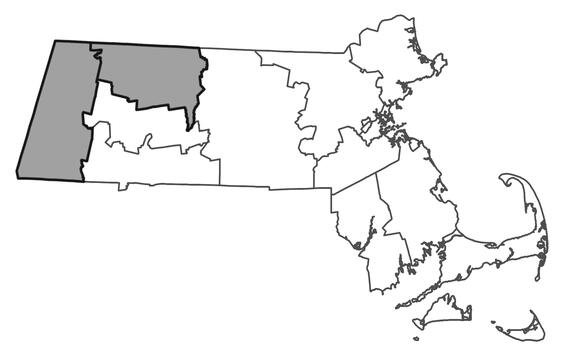- Scientific name: Cypripedium reginae
- Species of Greatest Conservation Need (MA State Wildlife Action Plan)
- Endangered (MA Endangered Species Act)
Description
Showy lady’s-slipper, a member of the orchid family, is a striking, two- or three-flowered, hairy perennial, usually 0.4-1.02 m (15-40 in) tall. The stem bears three to seven, coarse, elliptic to oval leaves, usually 10-23 cm (4-9 in) long and 5-12 cm (2-5 in) wide. The flowers have white sepals and white lateral petals. The lip petal or “slipper” is white and heavily suffused with magenta.
Pink lady’s-slipper (C. acaule) is similar to showy lady’s-slipper but is smaller (15-37 cm [6-15 in] in height), produces leaves only at the base of the plant, and flowers only at the top of a leafless stem. The sepals and lateral petals of the pink lady’s-slipper are brownish-green and the lip is uniformly dark pink and veined with red.
Life cycle and behavior
Flowering occurs from mid-June through early July.
Population status
Showy lady’s-slipper is listed as an Endangered species under the Massachusetts Endangered Species Act. The rarity of this plant is attributable to a scarcity of alkaline habitats, destruction of suitable habitats, and deer browsing. The MassWildlife’s Natural Heritage & Endangered Species Program database has 36 records from 5 counties: Berkshire, Essex, Franklin, Hampshire, and Middlesex. Thirteen of these records have been observed within the last 25 years.
Distribution and abundance
Showy lady’s-slipper ranges from Newfoundland to Manitoba, south to New Jersey, western Pennsylvania, Georgia, Tennessee, northern Indiana, Missouri, and North Dakota.

Distribution in Massachusetts
1999-2024
Based on records in the Natural Heritage Database
Habitat
Showy lady’s-slipper inhabits coniferous forested fens (wet, calcareous swamps) and naturally open peatlands influenced by calcareous (or alkaline) groundwater seepage. These communities tend to be dominated by Larix laricina (larch), Fraxinus nigra (black ash), Acer rubrum (red maple), Alnus rugosa (speckled alder), Cornus stolonifera (red-osier dogwood), and Geum rivale (water avens).
Healthy habitats are vital for supporting native wildlife and plants. Explore habitats and learn about conservation and restoration in Massachusetts.
Threats
Destruction of suitable habitats and deer browsing are the biggest threat to this orchid.
Contact
| Date published: | April 15, 2025 |
|---|